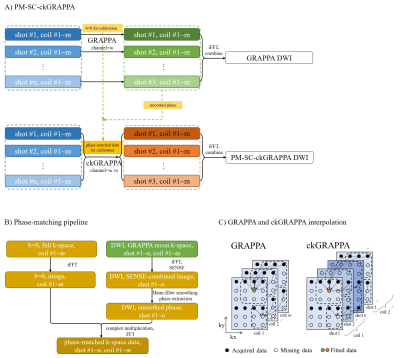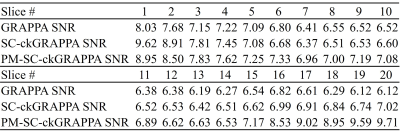0980
Phase-matched Self-calibrated K-space Phase Correction Method for Multi-shot Diffusion Imaging1China National Clinical Research Center for Neurological Diseases, Beijing Tiantan Hospital, Capital Medical University, Beijng, China, 2Center for Magnetic Resonance Research, University of Minnesota, Minneapolis, MN, United States, 3Center for Biomedical Imaging Research, Department of Biomedical Engineering, School of Medicine, Tsinghua University, Beijing, China, 4Philips Healthcare, Beijing, China, 5Department of Neurology, Beijing Tiantan Hospital, Capital Medical University, Beijing, China
Synopsis
Multi-shot acquisition enables high-resolution diffusion imaging, but the artifacts caused by shot-to-shot phase variation must be corrected. Self-calibrated multi-shot DWI methods utilize parallel imaging reconstruction to solve the phase of each shot. Previously reported self-calibrated GRAPPA with a compact kernel (SC-ckGRAPPA) method is compromised by the high reduction factor when recovering the navigator information. In this work, PM-SC-ckGRAPPA was introduced with the phase-matched reconstruction, and evaluated via in-vivo experiment. Results show that PM-SC-ckGRAPPA provides improved reconstruction compared with conventional approaches, and PM-SC-ckGRAPPA can be a potential tool for high-resolution diffusion imaging.
Purpose
Multi-shot EPI (MS-EPI) enables higher resolution diffusion weighted imaging (DWI) than single-shot EPI (SS-EPI), but the ghost artifacts caused by shot-to-shot phase variation must be corrected. Some k-space correction methods like ckGRAPPA (GRAPPA with a compact kernel) for interleaved MS-EPI DWI have been proposed, utilizing the phase variation from navigator acquisition as additional encoding power[1], to recover the missing data in k-space of each shot. Self-calibrated method SC-ckGRAPPA has also been proposed to avoid the mismatch between image and navigator echo and saves the scan time of navigator acquisition[2]. However, SC-ckGRAPPA is still compromised by the high reduction factor (R, equals the number of shots) when recovering the navigator information of each shot. Recently phase-matched reconstruction has been proposed to improve the performance of SS-EPI DWI GRAPPA reconstruction[3]. In this work, a phase-matched SC-ckGRAPPA reconstruction algorithm (PM-SC-ckGRAPPA) for MS-EPI DWI is proposed and evaluated using in-vivo experiment. This work aims to improve the self-calibrated k-space-based MS-EPI DWI reconstruction.Theory
Conventional GRAPPA: For conventional GRAPPA DWI reconstruction, each shot is reconstructed by GRAPPA separately using the convolution kernel calibrated from b = 0 multi-coil full k-space (assuming no phase variation in b = 0 acquisition). For an acquisition from m coils, GRAPPA calibration/interpolation performs on m channels. Then the GRAPPA reconstructed images from each shot are averaged to generate DWI[4].Conventional SC-ckGRAPPA: As described in previous work on ckGRAPPA[2], the multi-coil and multi-shot k-space data are integrated for k-space interpolation. Figure 1C illustrates GRAPPA and ckGRAPPA k-space interpolation process. Different from ckGRAPPA which relies on the navigator echo acquisition for calibration, the SC-ckGRAPPA calibrates on the GRAPPA recovered full k-space of all shots. For an n-shot with m-coil acquisition, SC-ckGRAPPA works on n×m channels.
Proposed PM-SC-ckGRAPPA: Previous works show the update of smoothed motion-induced phase variation improves DWI reconstruction, especially on MS-EPI with SENSE-like reconstruction[5,6] and SS-EPI with GRAPPA reconstruction[3]. In this work, the phase-matched reconstruction is incorporated in SC-ckGRAPPA. Different from SC-ckGRAPPA which directly uses GRAPPA results for calibration[2], PM-SC-ckGRAPPA calibrates on phase-matched synthetic data from b=0 multi-coil images and DWI smoothed phase variation, which is performed below: 1) the DWI k-space data for each shot recovered by GRAPPA are inverse Fourier transformed and SENSE-combined to generate navigator images; 2) the navigator image for each shot is smoothed using 2D Hann window filter, and the smoothed complex phase is extracted using cpxPha = nav / abs(nav); 3) the complex phase for each shot and b=0 image from each coil are combined using complex multiplication to generate phase-matched image data; 4) the phase-matched image data are Fourier transformed to generate the multi-shot, multi-coil phase-matched k-space data for PM-SC-ckGRAPPA reconstruction. Figure 1B illustrates the reconstruction of the phase-matched calibration data. The proposed PM-SC-ckGRAPPA reconstruction pipeline is shown in Figure 1A.
Methods
In order to compare different reconstruction approaches, 6-shot interleaved-EPI DWI data were acquired on a healthy volunteer on a 3T scanner (Philips, Best, The Netherlands) with an 8-channel head coil. FOV=210×210mm2, voxel size = 1×1×4 mm3, 20 slices with gap = 1mm, TE = 86 ms (set to minimum), TR = 3500 ms, no partial Fourier, 6 diffusion encoding directions using b=1000 s/mm2 were acquired with repetition = 2. On this dataset, three different reconstruction methods were implemented and compared: a) GRAPPA, b) SC-ckGRAPPA, c) proposed PM-SC-ckGRAPPA. For all ckGRAPPA k-space calibration and interpolation, the kernel size was 3×5 (kx×ky) and λ=1e-6 for calibration regularization. The noise map was calculated from the standard deviation of the difference between 2 repetitions of all encoding directions, namely NoiseMap = StdDiffusionEncoding(DiffRepietition(DWI)). The image SNR was calculated as [7] in the brain region for each encoding direction and each slice.Results and Discussion
Figure 2 shows the two typical slices of the 6-shot data reconstruction. SC-ckGRAPPA shows lower noise level than GRAPPA, and PM-SC-ckGRAPPA shows minimum noise and signal dropout levels compared with the other two methods. PM-SC-ckGRAPPA recovers the signal dropout compared with the conventional methods. The mean image from all diffusion encoding directions shows the potential of PM-SC-ckGRAPPA to be a new approach for high-resolution DWI. Figure 3 shows the phase images of 3 typical shots, reconstructed by GRAPPA, extracted in the phase-match process and reconstructed by PM-SC-ckGRAPPA, respectively. Compared with GRAPPA results, the phase of the PM-SC-ckGRAPPA shows reduced noise and artifacts. The mean image SNR of GRAPPA, SC-ckGRAPPA and PM-SC-ckGRAPPA is 6.67, 7.03 and 7.77 respectively. PM-SC-ckGRAPPA provides significantly higher SNR over other conventional methods (p < 0.001). Table 1 shows the averaged SNR of all encoding directions from all 20 slices.In this work, PM-SC-ckGRAPPA was introduced and evaluated for interleaved-EPI DWI with human brain acquisition. The strategy can be extended to multi-band and 3D multi-slab acquisitions, and the application scenario can be extended to other organs. As reported in previous works, the GRAPPA-based approach might be more robust than image-based reconstruction in DWI when subject motion occurs[4].
Conclusion
The proposed PM-SC-ckGRAPPA provides improved reconstruction compared with conventional GRAPPA and SC-ckGRAPPA. The interleaved MS-EPI acquisition with PM-SC-ckGRAPPA reconstruction can be a potential approach for high-resolution DWI.Acknowledgements
No acknowledgement found.References
[1] Ma X, Zhang Z, Dai E, Guo H. Improved multi-shot diffusion imaging using GRAPPA with a compact kernel. Neuroimage. 2016;138:88-99. doi:10.1016/j.neuroimage.2016.05.079
[2] Zhang Z, Ma X, Dai E, Zhang H, Guo H. Self-calibrated K-space Phase Correction Method for Multi-shot Diffusion Imaging. In: Proc. Intl. Soc. Mag. Reson. Med. 24 (2016). 2016:3020.
[3] Liao C, Manhard MK, Bilgic B, et al. Phase-matched virtual coil reconstruction for highly accelerated diffusion echo-planar imaging. Neuroimage. 2019;194(November 2018):291-302. doi:10.1016/j.neuroimage.2019.04.002
[4] Skare S, Newbould RD, Clayton DB, Albers GW, Nagle S, Bammer R. Clinical multishot DW-EPI through parallel imaging with considerations of susceptibility, motion, and noise. Magn Reson Med. 2007;57(5):881-890. doi:10.1002/mrm.21176
[5] Chen N kuei, Guidon A, Chang HC, Song AW. A robust multi-shot scan strategy for high-resolution diffusion weighted MRI enabled by multiplexed sensitivity-encoding (MUSE). Neuroimage. 2013;72:41-47. doi:10.1016/j.neuroimage.2013.01.038
[6] Zhang Z, Huang F, Ma X, Xie S, Guo H. Self-feeding MUSE: A robust method for high resolution diffusion imaging using interleaved EPI. Neuroimage. 2015;105:552-560. doi:10.1016/j.neuroimage.2014.10.022
[7] Dietrich O, Raya JG, Reeder SB, Reiser MF, Schoenberg SO. Measurement of signal-to-noise ratios in MR images: Influence of multichannel coils, parallel imaging, and reconstruction filters. J Magn Reson Imaging. 2007;26(2):375-385. doi:10.1002/jmri.20969
Figures



